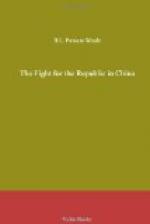The region which goes by the name of Chientao, a Japanese denomination, comprises several districts in the Yenchi Circuit of Kirin Province north of the Tumen Kiang (or the Tiumen River) which here forms the boundary between China and Korea. For over thirty years Koreans have been allowed here to cultivate the waste lands and acquire ownership therein, a privilege which has not been permitted to any other foreigners in China and which has been granted to these Koreans on account of the peculiar local conditions. According to reliable sources, the Korean population now amounts to over 200,000 which is more than the Chinese population itself. In 1909 an Agreement, known as the Tumen Kiang Boundary Agreement, was arrived at between China and Japan, who was then the acknowledged suzerain of Korea, dealing, inter alia, with the status of these Koreans. It was provided that while Koreans were to continue to enjoy protection of their landed property, they were to be subject to Chinese laws and to the jurisdiction of Chinese courts. The subsequent annexation of Korea did not affect this agreement in point of international law, and as a matter of practice Japan has adhered to it until September, 1915. Then the Japanese Consul suddenly interfered in the administration of justice by the local authorities over the Koreans and claimed that he should have jurisdiction.
The Japanese claim is based on the Treaty Respecting South Manchuria and Eastern Inner Mongolia signed in May, 1915, article 5 of which provides that civil and criminal cases in which the defendants are Japanese shall be tried and adjudicated by the Japanese consul.
The Chinese view is that this article is inapplicable to Koreans in this region and that the Tumen Kiang Agreement continues in force. This view is based on a saving clause in article 8 of the Treaty of 1915 which says that “all existing treaties between China and Japan relating to Manchuria shall, except where otherwise provided for by treaty, remain in force.”
In the first place, the origin of the Tumen Kiang Agreement supports this view. When the Japanese assumed suzerainty over Korea they raised certain questions as to the boundary between China and Korea. There were also outstanding several questions regarding railways and mines between China and Japan. Japan insisted that the boundary question and the railway and mining questions be settled at the same time. As a result, two agreements were concluded in 1909 one respecting the boundary question, the Tumen Kiang Agreement, and the other respecting railways and mines whereby Japan obtained many new and valuable privileges and concessions, such as the extension of the Kirin-Changchun Railway to the Korean frontier, the option on the Hsinminfu-Fakumen line, and the working of the Fushun and Yentai mines, while in return China obtained a bare recognition of existing rights, namely the boundary between China and Korea and the jurisdiction over the Koreans in the Yenchi region. The two settlements were in the nature of quid pro quo though it is clear that the Japanese side of the scale heavily outweighed that of the Chinese. Now Japan endeavours to repudiate, for no apparent reason so far as we can see, the agreement which formed the consideration whereby she obtained so many valuable concessions.




